Quality Assurance
Inspectorate and Security Unit Complaints Investigation Unit Management Services Unit
Quality Assurance Division continued to conduct timely review and initiate enhancements for upholding the performance standard of the Department in 2015.
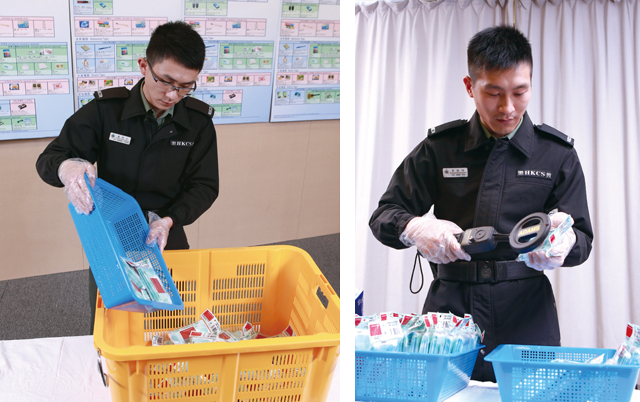
Staff of the Security Section under the Quality Assurance Division examine meticulously all hand-in articles to ensure the security of institutions.
[Back to top]
Inspectorate and Security Unit
The Inspectorate Sub-unit is committed to providing systematic and quality inspections to correctional facilities to ensure that the departmental policies are followed, rules and regulations are duly complied with, approved practices and standards are consistently maintained, and resources are gainfully deployed to enhance efficiency.
In 2015, the Inspectorate Sub-unit conducted a total of five full inspections, 17 thematic inspections, 13 follow-up inspections, nine security inspections and 12 surprise inspections to various correctional facilities.
To uphold the performance standard of the Department and address public aspirations that come with the ever-changing society and penal environment, the Inspectorate Sub-unit continued to contribute enhancement initiatives particularly relating to security facilities and procedures. In 2015, the Inspectorate Sub-unit completed the thematic study on “Closed Circuit Television (CCTV) System” in which software control and analytical functions will be included to assist in the real time monitoring and reviewing of CCTV footages. The Inspectorate Sub-unit also completed an overall review on the specification and requirement for security installations of correctional facilities for continuous service enhancement.
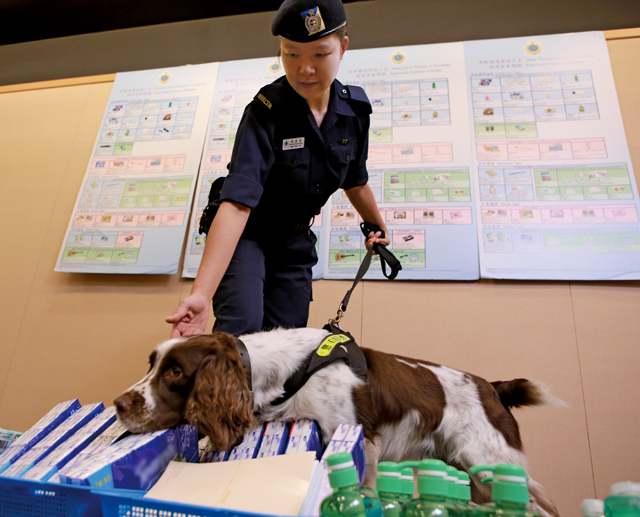
Sniffing dog assists in checking hand-in articles.
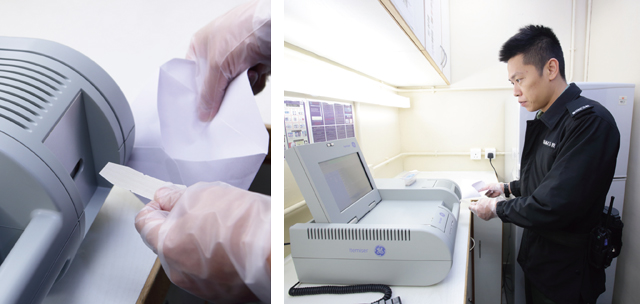
Staff use the Narcotics and Explosives Detection and Identification System to stamp out the smuggling of dangerous drug and explosive items into correctional institutions.
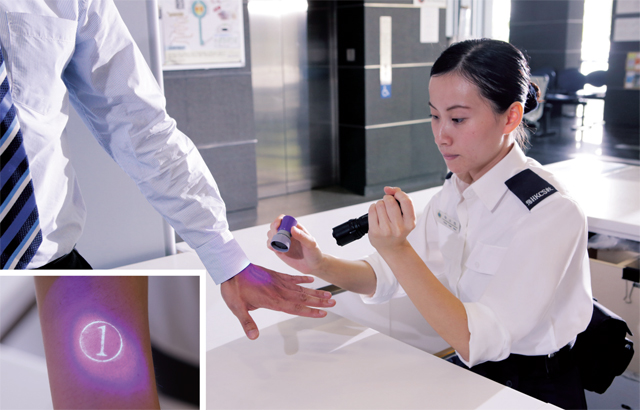
Staff use invisible ink stamp to strengthen the security control on visitors entering and leaving institutions.
In 2015, the Security Sub-unit made every effort to stamp out the smuggling of contrabands into correctional institutions for a drug-free environment. There were 33 cases of discovering dangerous drugs, all were intercepted on the doorstep of the institutions.
Wiping out gambling and illicit activities in correctional facilities is an important mission of the Security Sub-unit. In order to reduce gambling and other illicit activities, sound intelligence networks were built up and frequent searching operations were enforced. In 2015, 569 joint searching operations, 7 385 special searching operations and 84 night raid operations were conducted in institutions with fruitful results.
On the training front, the Inspectorate and Security Unit organised job-related training courses for QAD officers with scenario training on “Searching Technique” and professional academics on “Risk Management” and “Legal Training on Judicial Review”.
To strive for continuous service improvement, the Singapore Prison Service was invited to send an audit team for conducting an overall review on the inspection mechanism of QAD.
[Back to top]
Complaints Investigation Unit
Appointed by the Commissioner of Correctional Services, the Complaints Investigation Unit (CIU) handles and investigates all complaints within its purview, the results of which are examined by the Correctional Services Department Complaints Committee (CSDCC). Customer Satisfaction Surveys are conducted in order to gauge satisfaction with CIU services in terms of mannerism, professionalism and efficiency. In 2015, the satisfaction rating was over 90%. CIU introduced the international quality management system in 2000 and was accredited certificate by the Hong Kong Quality Assurance Agency in August 2000 and then upgraded to ISO 9001: 2008 in January 2009, which demonstrated the efforts of CIU in making continuous improvements. In February 2014, the certificate was renewed by the HKQAA till 2017.
For the improvement and enhancement of staff working knowledge, CIU uploaded complaints statistics and recommendations endorsed by CSDCC as well as cases of interest to the "Knowledge Management System" and "Smart QA Info" of CSD Intranet on quarterly basis. CIU continued to adopt mediation service to resolve minor complaints.
In 2015, CIU received 342 complaint cases / requests / enquiries from persons in custody and the public. Among them, 106 complaint cases entailed full investigation by CIU, 61 complaint cases entailed handling by institutions under CIU monitoring, 72 were repeated complaints, 103 were requests / enquiries. Besides, CSDCC examined and endorsed the investigation reports on a total of 114 complaint cases and made 25 recommendations for service improvement.

The Complaints Investigation Unit officers conduct detailed investigation into all cases, including reviewing CCTV footage.
[Back to top]
Management Services Unit
The Management Services Unit constantly reviewed the relevant legislation under the Department's purview, departmental standing orders and operational manuals to ensure that they were in line with operational needs and able to meet the demands arising from the changing environment in society. The Unit also conducted researches in the application of technology for operational and security enhancement.
In 2015, three low-radiation X-ray body scanners were procured for Lai King Correctional Institution, Siu Lam Psychiatric Centre and Lai Chi Kok Reception Centre, making a total of seven scanners installed at all reception centres. After the completion of installation works in 2016, most of the manual rectal search conducted on persons in custody would be replaced.
Radio Frequency Identification Technology (RFID) System commenced for use in 20 penal institutions in 2015 for better management of staff accoutrements including oleoresin capsicum foams, extendable truncheons and security keys. The system was effective in assisting the main gate staff to control the in and out of staff accoutrements. The Unit has initiated further study to use handheld RFID scanner to facilitate inventory check.
The Unit introduced the second Human Presence Detection System at Stanley Prison in 2015 to assist staff to effectively detect any persons in custody who attempts to escape by hiding in vehicles.
In collaboration with Escort and Support Group, the Unit was testing the effectiveness in live transmission of the images captured by Unmanned Aircraft System during emergency.
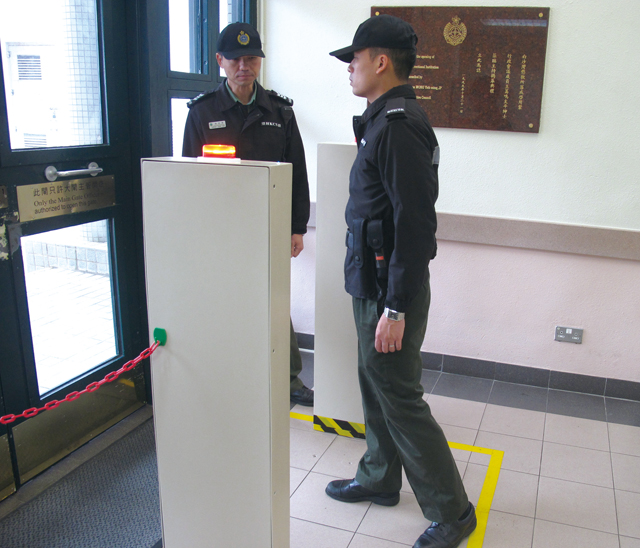
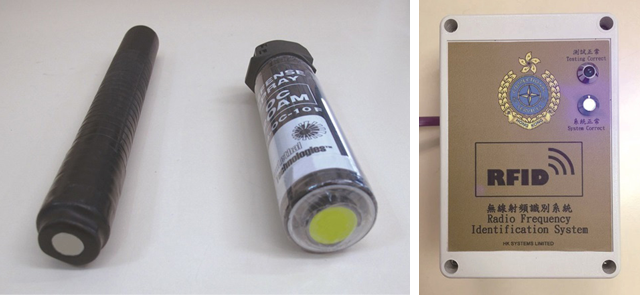
Radio Frequency Identification Technology System was introduced in 2015 to assist main gate staff to control the in and out of staff accoutrements, including oleoresin capsicum foams, extendable truncheons and security keys.
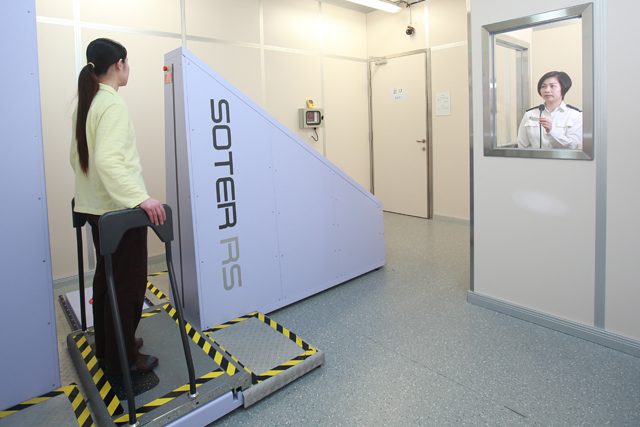
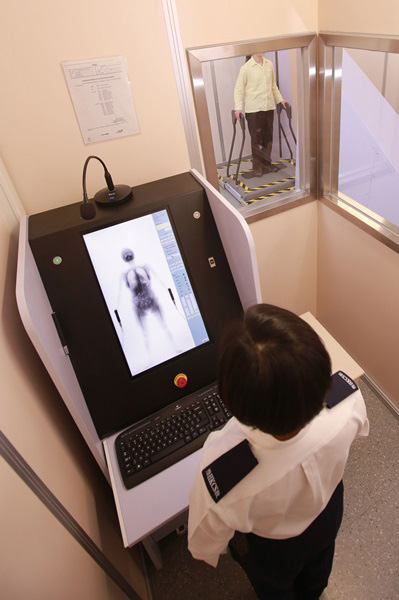
An low-radiation X-ray body scanner is installed at Lo Wu Correctional Institution to replace manual rectal search conducted on persons in custody.
[Back to top]